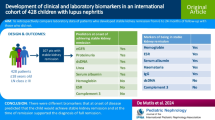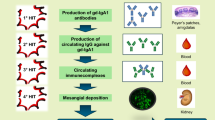Abstract
Henoch–Schönlein purpura (HSP) is a small-vessel disease in children that is often accompanied by kidney damage. Despite many efforts to improve the early assessment of renal injury in HSP patients, effective markers are still lacking. In recent years, the relationship between kidney injury molecule-1 (KIM-1) and tubulointerstitial injury has drawn much attention, especially regarding the diagnostic potential of serum and urinary KIM-1 levels. However, the diagnostic value of KIM-1 for detecting urinary kidney injury in HSP patients is still elusive. Furthermore, the treatment of Henoch–Schönlein purpura nephritis (HSPN) relies on the clinician’s experience without performing renal biopsy, so it is important to find an effective biomarker and therapy. In the present study, we investigated the diagnostic value of urinary KIM-1 for early renal injury in HSP patients enrolled in a prospective, single-center study. Urinary KIM-1 levels were measured in 27 patients with HSP, 32 patients with HSPN (21 HSPN patients had undergone renal biopsy), and 16 healthy donors, as normal controls. The HSPN patients were randomly divided to receive either routine therapy (n = 13) or routine treatment combined with creatine phosphate sodium (CP) (n = 19). Urinary KIM-1 levels were significantly greater in the HSP and HSPN groups than those in the healthy control group (P < 0.01), and were significantly greater in the HSPN group than in the HSP group (P < 0.01). The urinary KIM-1 levels decreased significantly after 10–14 days of treatment with CP compared with conventional therapy (P < 0.05).
Conclusion: Our results demonstrate the diagnostic value of KIM-1 and the therapeutic potential of CP for early renal damage in HSP patients.
“What is Known” • Urine kidney injury molecule-1 (KIM-1) is a sensitive biomarker for tubulointerstitial injury. • Henoch–Schonlein purpura (HSP) usually presents with renal damage. |
“What is New” • Our results suggest that the urinary KIM-1 level is a sensitive and specific biomarker for the detection of early renal damage in HSP and may predict the severity of HSP and HSPN. • The administration of creatine phosphate sodium (CP) may reduce urinary KIM-1 levels and thus correct the hypoxic condition of the kidney. Preconditioning with CP may also be a useful adjunct for preventing early renal damage in HSPN patients. |

Similar content being viewed by others
Abbreviations
- AUC:
-
Area under the curve
- CP:
-
Creatine phosphate
- HSP:
-
Henoch–Schönlein purpura
- HSPN:
-
Henoch–Schönlein purpura nephritis
- KIM-1:
-
Kidney injury molecule-1
- NAG:
-
N-acetyl-β-d-glucosamidase
- ROC:
-
Receiver operator characteristic
References
Amannn K, Benz K (2009) Work-up of a renal biopsy: what is established? What will follow? Der Pathologe 30:94–100
Amoli MM, Thomson W, Hajeer AH, Calviño MC, Garcia-Porrua C, Ollier WE, Gonzalez-Gay MA (2002) Interleukin 1 receptor antagonist gene polymorphism is associated with severe renal involvement and renal sequelae in Henoch-Schönlein purpura. J Rheumatol 29(7):1404–7
Amoli MM, Thomson W, Hajeer AH, Calviño MC, Garcia-Porrua C, Ollier WE, Gonzalez-Gay MA (2002) Interleukin 8 gene polymorphism is associated with increased risk of nephritis in cutaneous vasculitis. J Rheumatol 29(11):2367–70
Arfian N, Emoto N, Vignon-Zellweger N, Nakayama K, Yagi K, Hirata K (2012) ET-1 deletion from endothelial cells protects the kidney during the extension phase of ischemia/reperfusion injury. Biochem Biophys Res Commun 425:443–449
Boubred F, Saint-Faust M, Buffat C, Ligi I, Grandvuillemin I, Simeoni U (2013) Developmental origins of chronic renal disease: an integrative hypothesis. Int J Nephrol 2013:346067
Briguori C, Quintavalle C, Donnarumma E (2014) Novel biomarkers for contrast-induced acute kidney injury. Biomed Res Int 2014:568738
Buck CL, Wallman KE, Dawson B, Guelfi KJ (2013) Sodium phosphate as an ergogenic aid. Sports Med 43:425–435
Bunchman TE, Mauer SM, Sibley RK, Vernier RL (1988) Anaphylactoidpurpura: characteristics of 16 patients who progressed to renal failure. Pediatr Nephrol 2:393–397
Chaturvedi S, Farmer T, Kapke GF (2009) Assay validation for KIM-1: human urinary renal dysfunction biomarker. Int J Biol Sci 5:128–134
Du Y, Hou L, Guo J, Sun T, Wang X, Wu Y (2014) Renal neutrophil gelatinase-associated lipocalin and kidney injury molecule-1 expression in children with acute kidney injury and Henoch–Schönleinpurpura nephritis. Exp Ther Med 7:1130–1134
Elena T, Christine A, Julien H, Hala W, Bilal A, Stephane D, Georges D, Tim U (2014) Even mild cases of paediatric Henoch- Schönlein purpura nephritis show significant long-term proteinuria. Acta Pædiatrica. doi:10.1111/apa.12723
Erdogan O, Oner A, Aydin A, Isimer A, Demircin G, Bulbul M (2003) Effect of vitamin E treatment on the oxidative damage occurring in Henoch–Schönleinpurpura. Acta Paediatr 92:546–550
García-Porrúa C, Calviño MC, Llorca J, Couselo JM, González-Gay MA (2002) Henoch-Schönlein purpura in children and adults: clinical differences in a defined population. Semin Arthritis Rheum 32(3):149–56
Gardner-Medwin JM, Dolezalova P, Cummins C, Southwood TR (2002) Incidence of Henoch-Schönleinpurpura, Kawasaki disease, and rare vasculitides in children of different ethnic origins. Lancet 360:1197–1202
Han WK, Waikar SS, Johnson A, Betensky RA, Dent CL, Devarajan P, Bonventre JV (2008) Urinary biomarkers in the early diagnosis of acute kidney injury. Kidney Int 73:863–869
Ichimura T, Bonventre JV, Bailly V, Wei H, Hession CA, Cate RL, Sanicola M (1998) Kidney injury molecule-1 (KIM-1), a putative epithelial cell adhesion molecule containing a novel immunoglobulin domain, is up-regulated in renal cells after injury. J Biol Chem 273:4135–4142
Ichimura T, Hung CC, Yang SA, Stevens JL, Bonventre JV (2004) Kidney injury molecule-1: a tissue and urinary biomarker for nephrotoxicant-induced renal injury. Am J Physiol Renal Physiol 286:F552–F563
Kawasaki Y (2011) The pathogenesis and treatment of pediatric Henoch-Schönleinpurpura nephritis. Clin Exp Nephrol 15:648–657
Keskin N, Civilibal M, Elevli M, Koldas M, Duru NS, Ozturk H (2011) Elevated plasma advanced oxidation protein products in children with Henoch–Schönleinpurpura. Pediatr Nephrol 26:1989–1993
Kramer AB, van Timmeren MM, Schuurs TA, Vaidya VS, Bonventre JV, van Goor H, Navis G (2009) Reduction of proteinuria in adriamycin-induced nephropathy is associated with reduction of renal kidney injury molecule (Kim-1) over time. Am J Physiol Renal Physiol 296:F1136–F1145
Kwon SH, Park MY, Jeon JS, Noh H, Choi SJ, Kim JK, Hwang SD, Jin SY, Han DC (2013) KIM-1 expression predicts renal outcomes in IgA nephropathy. Clin Exp Nephrol 17:359–364
Li H, Thali RF, Smolak C, Gong F, Alzamora R, Wallimann T, Scholz R, Pastor-Soler NM, Neumann D, Hallows KR (2010) Regulation of the creatine transporter by AMP-activated protein kinase in kidney epithelial cells. Am J Physiol Renal Physiol 299:F167–F77
Liangos O, Tighiouart H, Perianayagam MC, Kolyada A, Han WK, Wald R, Bonventre JV, Jaber BL (2009) Comparative analysis of urinary biomarkers for early detection of acute kidney injury following cardiopulmonary bypass. Biomarkers 14:423–431
Liu S, Soong Y, Seshan SV, Szeto HH (2014) Novel cardiolipin therapeutic protects endothelial mitochondria during renal ischemia and mitigates microvascular rarefaction, inflammation, and fibrosis. Am J Physiol Renal Physiol 306:F970–F980
Nakae I, Mitsunami K, Omura T, Yabe T, Tsutamoto T, Matsuo S, Takahashi M, Morikawa S, Inubushi T, Nakamura Y, Kinoshita M, Horie M (2003) Proton magnetic resonance spectroscopy can detect creatine depletion associated with the progression of heart failure in cardiomyopathy. J Am Coll Cardiol 42:1587–1593
Nangaku M (2004) Hypoxia and tubulointerstitial injury: a final common pathway to end-stage renal failure. Nephron Exp Nephrol 98:e8–e12
Narchi H (2005) Risk of long term renal impairment and duration of follow up recommended for Henoch–Schönleinpurpura with normal or minimal urinary findings: a systematic review. Arch Dis Childhood 90:916–920
Norman JT, Clark IM, Garcia PL (2000) Hypoxia promotes fibrogenesis in human renal fibroblasts. Kidney Int 58:2351–2366
Ozen S, Pistorio A, Iusan SM, Bakkaloglu A, Herlin T, Brik R, Buoncompagni A, Lazar C, Bilge I, Uziel Y, Rigante D, Cantarini L, Hilario MO, Silva CA, Alegria M, Norambuena X, Belot A, Berkun Y, Estrella AI, Olivieri AN, Alpigiani MG, Rumba I, Sztajnbok F, Tambic-Bukovac L, Breda L, Al-Mayouf S, Mihaylova D, Chasnyk V, Sengler C, Klein-Gitelman M, Djeddi D, Nuno L, Pruunsild C, Brunner J, Kondi A, Pagava K, Pederzoli S, Martini A, Ruperto N, Paediatric Rheumatology International Trials Organisation (PRINTO) (2010) EULAR/PRINTO/PRES criteria for Henoch–Schönleinpurpura, childhood polyarteritisnodosa, childhood Wegener granulomatosis and childhood Takayasu arteritis: Ankara 2008. Part II: Final classification criteria. Ann Rheum Dis 69:798–806
Parikh CR, Butrymowicz I, Yu A, Chinchilli VM, Park M, Hsu CY, Reeves WB, Devarajan P, Kimmel PL, Siew ED, Liu KD, ASSESS-AKI Study Investigators (2014) Urine stability studies for novel biomarkers of acute kidney injury. Am J Kidney Dis 63:567–572
Park SJ, Suh JS, Lee JH, Lee JW, Kim SH, Han KH, Shin JI (2013) Advances in our understanding of the pathogenesis of Henoch-Schönleinpurpura and the implications for improving its diagnosis. Expert Rev Clin Immunol 9:1223–1238
Pennemans V, De Winter LM, Faes C, Van Kerkhove E, Reynders C, Rigo JM, Swennen Q, Penders J (2010) Effect of pH on the stability of kidney injury molecule 1 (KIM-1) and on the accuracy of its measurement in human urine. Clin Chim Acta 411:2083–2086
Prabhakar G, Vona-Davis L, Murray D, Lakhani P, Murray G (2003) Phosphocreatine restores high-energy phosphates in ischemic myocardium: implication for off-pump cardiac revascularization. J Am Coll Surg 197:786–791
Roberts BN, Christini DJ (2012) The relative influences of phosphometabolites and pH on action potential morphology during myocardial reperfusion: a simulation study. PloS One 7:e47117
Rodriguez R, Stepke M, Maitz S, Cuono CB, Sumpio BE (1991) Amelioration of renal ischemic injury by phosphocreatine. J Surg Res 51:271–274
Rueda B, Perez-Armengol C, Lopez-Lopez S, Garcia-Porrua C, Martín J, Gonzalez-Gay MA (2006) Association between functional haplotypes of vascular endothelial growth factor and renal complications in Henoch-Schönlein purpura. J Rheumatol 33(1):69–73
Stewart M, Savage JM, Bell B, McCord B (1988) Long term renal prognosis of Henoch-Schönleinpurpura in an unselected childhood population. Eur J Pediatr 147:113–115
Takeshi N, Hiroshi K, Kandai N, Yuya H, Kyoko K, Ichiro K, Yuko S, Kiyoshi H, Koichi N, Ryojiro T, Norishige Y, Kazumoto I, Matsuo M (2011) Treatment strategies for Henoch-Schönlein purpura nephritis by histological and clinical severity. Pediatr Nephrol 26:563–569
Vaidya VS, Ramirez V, Ichimura T, Bobadilla NA, Bonventre JV (2006) Urine kidney injury molecule-1: a sensitive quantitative biomarker for early detection of kidney tubular injury. Am J Physiol Renal Physiol 290:F517–F529
Xu PC, Zhang JJ, Chen M, Lv JC, Liu G, Zou WZ, Zhang H, Zhao MH (2011) Urinary kidney injury molecule-1 in patients with IgA nephropathy is closely associated with disease severity. Nephrol Dial Transplant 26:3229–3236
Yoshikawa N, Ito H, Yoshiya K, Nakahara C, Yoshiara S, Hasegawa O, Matsuyama S, Matsuo T (1987) Henoch-Schönlein nephritis and IgA nephropathy in children: a comparison of clinical course. Clin Nephrol 27:233–237
Zhang Z, Humphreys BD, Bonventre JV (2007) Shedding of the urine biomarker kidney injury molecule-1 (KIM-1) is regulated by MAP kinases and juxtamembrane region. J Am Soc Nephrol 18:2704–2714
Conflict of interest
The authors have no personal financial or institutional interests or conflicts of any kind in relation to any of the drugs, materials, or devices described in this article.
This study was funded by the Natural Science and Technique Foundation of Henan Province (no. 122102310213 to J-JZ) and by the Health Department of Henan Province (no. 2011020025 to J-JZ).
Author’s Contributions
Jianjiang Zhang is responsible for the overall ideas and modifying articles.
Huiqin Zeng is responsible for the operation and writing the article initially.
Na Wang is responsible for the patients and data collection.
Xiyan Tian is responsible for the collection of urine samples and measurement of urinary KIM-1 levels.
Wenjie Dou is responsible for the statistical analysis.
Peipei Shi is responsible for modifying articles.
Author information
Authors and Affiliations
Corresponding author
Additional information
Communicated by Jaan Toelen
Revisions received: 09 April 2015 / 10 June 2015
Rights and permissions
About this article
Cite this article
Zhang, J., Zeng, H., Wang, N. et al. Beneficial effects of creatine phosphate sodium for the treatment of Henoch–Schönlein purpura in patients with early renal damage detected using urinary kidney injury molecule-1 levels. Eur J Pediatr 175, 49–55 (2016). https://doi.org/10.1007/s00431-015-2601-x
Received:
Revised:
Accepted:
Published:
Issue Date:
DOI: https://doi.org/10.1007/s00431-015-2601-x




